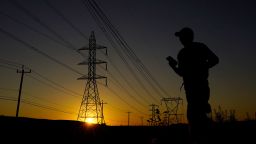Tucked into President Joe Biden’s ambitious, sweeping climate commitments is a crucially important goal that dates back to his campaign: Transforming the US electric grid to run entirely on clean energy by 2035.
The goal could make or break Biden’s pledge to slash the country’s planet-warming emissions in half by 2030. And if successful, 100% clean electricity could energize vast sectors of the US economy: electric vehicles, home and office heating and cooling, and appliances. It could even power heavy industry and manufacturing, which is currently reliant on fossil fuels.
“When you have a fully clean grid, versus a grid that either is a quarter or a half clean, that makes a significant difference in terms of the greenhouse gas performance of the things you’re plugging in to that grid,” White House national climate adviser Ali Zaidi told CNN. “That electric vehicle now is twice or three times cleaner when you shift to a fully clean grid.”
Yet while renewable energy has exploded over the past decade, bringing Biden’s cornerstone climate goal to fruition by 2035 could be beyond his grasp.
As of this year, about 44% of America’s electricity was powered by zero-emissions sources like wind, solar, nuclear and hydropower, according to the Department of Energy. The rest comes from fossil fuels like methane gas and coal.
After the Inflation Reduction Act passed last year – legislation that aimed to supercharge clean energy in the US – an analysis from the National Renewable Energy Laboratory predicts the US will get to around 80% clean electricity by 2030, a number that includes renewables, nuclear energy and carbon capture on fossil fuel plants.
By 2035, the federal analysis shows clean and renewable sources will make up about 86% of US energy, spurred in large part by the IRA. (That analysis did not include the Biden administration’s proposed pollution rules for power plants, which could increase the adoption of clean energy.)
“That’s a doubling from today, which is huge,” Ben King, an associate director at the nonpartisan think tank Rhodium Group, told CNN. But it’s also short of Biden’s goal of 100% clean electricity by that date.
Decarbonizing the last portion of the power sector will be the most difficult, federal officials and experts told CNN. The closer you get to 100% percent clean electricity, the harder it is to go all the way.
“We’ve known that the last 10% – maybe the last 20 to 25% – is going to be challenging,” Zaidi said. “And the reason is because you’re not just trying to deliver clean electrons onto the grid. You’re trying to deliver cleaner electrons when you want them, where you want them. That’s a hard thing to do.”
Not only does the power need to come from clean sources, it also needs to be readily available to energize the US economy during peak demand.
But wind and solar are still variable – especially without massive, costly battery storage. And newer technologies, like green hydrogen, carbon capture and small modular nuclear reactors haven’t yet been built to a large enough scale.
That could mean some fossil fuels plants outfitted with carbon capture would need to remain connected to the grid to provide power that can brought online quickly, King said.
There are also big infrastructure hurdles for renewables to take the lead. Even if massive amounts of wind and solar are developed by the end of this decade, the US may not have enough electrical transmission infrastructure to move all of that renewable energy around the grid.
“The bottlenecks of a lack of transmission are very real,” Lena Moffitt, executive director of Evergreen Action, told CNN. There also needs to be significant investment in massive batteries to store the power generated by wind and solar to be used at all hours, she said.
Wind and solar are the workhorses
While companies and the federal government are racing to scale up new zero-carbon technologies, traditional wind and solar will largely power this clean electricity transition.
They are the most reliable and trusted clean energy sources for utilities and developers, and they have quickly become cheaper than fossil fuels – so inexpensive that it is becoming more cost-effective for some utilities to build new wind and solar, rather than constructing new fossil plants or even running existing ones, experts told CNN.
Wind and solar are also mature technologies that developers know they can finance and get huge tax breaks on through the Inflation Reduction Act.
They are the “natural choice for developers who are looking for those low risk and very cost-effective projects to develop,” Sonia Aggarwal, a former White House senior advisor for climate policy and CEO of nonpartisan think tank Energy Innovation, told CNN. “We will see them play a large role because of how good they look from an economic perspective.”
By the end of 2021, wind and solar together made up about 228 gigawatts of power. By 2034, NREL predicts that number – including offshore wind – will grow by more than four times to over 1 terawatt, or 1 trillion watts of power.
“Where we are now is very different from even 5 or 10 years ago as far as the costs of clean energy, particularly renewables, being significantly lower than they’ve been in the past,” Carla Frisch, acting executive director of the US Energy Department’s Office of Policy, told CNN. “So just a really rapid acceleration that we’re already experiencing right now.”
While getting new clean technologies to scale will be difficult, it’s work worth doing, Zaidi said.
“Let’s deploy the stuff we have right now, right away,” he said. “And let’s work hard as we can to innovate on the stuff that we need in the future.”








